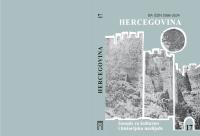Oslobođenici u zaleđu Narone (epigrafsko-prosopografska analiza)
FREEDMAN IN THE HINTERLAND OF NARONA (EPIGRAPHIC AND PROSOPOGRAPHIC ANALYSIS)
Author(s): Almir MarićSubject(s): History, Archaeology, Ancient World
Published by: Fakultet humanističkih nauka, Univerzitet »Džemal Bijedić« u Mostaru
Keywords: freedman; Narona; Ljubuški;Čapljina;Humac;social structures;
Summary/Abstract: This paper, based on epigraphic and prosopographic analysis, deals with epigraphic monuments referring to the freedmen in the hinterland of ancient city Narona. The identification of members of this social structure was carried out by certain nouns from the inscriptions, the context in which they were found, as well as onomastic characteristics of the names mentioned on them. Freedmen who have been registered in the hinterland of Narona have been mostly located in the wide area of lower Neretva. The monuments that are analyzed for the purposes of this paper have been found primarily in the areas around the modern towns of Ljubuški and Čapljina. Monuments of freedmen from those towns reveal certain specificities e.g. most of the freedmen’s inscriptions found in present-day Čapljina were connected to the rich Atilius family. Most probably did the freedmen of this family come to the hinterland of Narona for the purpose of expanding their trade towards the inland or to start their own businesses, regardless of the rich patrons. On the other hand, the features of freedmen’s inscriptions from the area of present-day Ljubuški reveal that they had been erected by different Roman army units that were stationed there from the 1st to the 3rd century. That fact suggests that freedmen from those inscriptions were mostly in the service of active soldiers and veterans, carrying out different tasks for them. They could not be engaged in an active military service, except in special cases when they responded to a call in extraordinary war situations. The freedmen who were introduced to the monuments were probably in a certain way close to the master, which is manifested by their presence on the tombstone. A large number of other freedmen, who performed various jobs for masters during their service, obviously did not achieve such a level of personal connectivity to be listed on the tombstone as heirs or persons whom he considered sufficiently close to be mentioned in such an important place.
Journal: Hercegovina
- Issue Year: 2018
- Issue No: 17
- Page Range: 37-57
- Page Count: 21
- Language: Bosnian
- Content File-PDF

